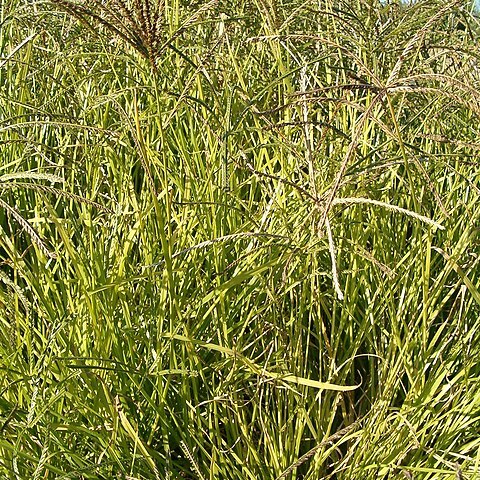Tufted annuals or tussocky perennials from a short ascending rhizome; culms slender to robust, flattened. Leaf-blades linear, usually folded; ligule membranous, truncate, often ciliate; leaf-sheaths keeled. Inflorescence digitate or shortly racemose, composed of a number of secund spikes clustered at the top of the culm. Spikelets several-flowered, ovate to narrowly oblong, laterally compressed, biseriate, usually closely overlapping, disarticulating between the florets; glumes 1-several-nerved, keeled, shorter than the lemmas, persistent; lemmas 3-nerved, keeled, sometimes with additional nerves on either side of the keel, elliptic to oblong, membranous, glabrous, the lateral nerves shorter than the lemma, the tip entire, obtuse to acute. Grain enclosed within a free hyaline pericarp, blackish (except in E. coracana), the surface ornamented, usually obtusely trigonous in cross-section.
Annuals or tussocky perennials. Culms compressed. Leaf sheaths strongly keeled; leaf blades linear, usually folded; ligule membranous, usually with a ciliate fringe. Inflorescence of digitate or subdigitate spikelike racemes clustered at the top of the culm; racemes with closely imbricate, biseriate spikelets, terminating in a fertile spikelet. Spikelets laterally compressed, florets several, disarticulating between the florets (except the cultivated species E. coracana); glumes shorter than lemmas, persistent, 1–3(–7)-veined, keeled, awnless; lemmas membranous, 3-veined, glabrous, strongly keeled, keel thickened with 1–3 closely spaced additional veins, obtuse or acute. Grain ellipsoid to subglobose, trigonous in section, ornamented, pericarp free. x = 9. Fl. and fr. Jul–Sep.
Spikelets several-fld, articulated above the glumes, the terminal ones in each spike well developed; glumes unequal, the first shorter, 1-veined, the second strongly 3-or 5-veined, shorter than the lemmas but resembling them; lemmas compressed, ovate to lanceolate, acute to acuminate, strongly 3-or 5-veined, the veins approximate and parallel near the keel; grain ellipsoid to ovoid, rugose; annuals with compressed culms and keeled sheaths; ligule membranous, ciliate or erose; blades flat, soft; spikes digitate and terminal, or with 1 or 2 lateral ones, with flat rachis and densely crowded, divergent spikelets. 9, warm reg.
Spikelets few-to several-flowered, compressed, sessile in two rows on one side of a rather broad rachis; rachilla disarticulating above the glumes and between the florets; glumes shorter than the first floret, unequal, the first 1-nerved, the second 3-to 5-nerved, the lateral nerves approximate close to the keel; lemmas acute, 3-nerved, the nerves close together, the uppermost somewhat reduced; seed dark brown, roughened by fine ridges, loosely enclosed in the thin pericarp. Annual grasses with two to several racemes digitate at the summit of the culms, sometimes with one or two a short distance below.
Spikelets several-flowered, laterally compressed, disarticulating above the glumes and between the florets (the florets persistent in cultivated races); glumes 1–several-nerved, keeled, shorter than the lemmas, persistent, awnless; lemmas 3-nerved, membranous, strongly keeled, sometimes the keels thickened and containing 1–3 closely spaced additional nerves on either side, glabrous, obtuse to acute or rarely mucronate.
Inflorescence composed of digitate or subdigitate racemes, the axis shorter than the longest raceme (rarely longer), the racemes with imbricate, biseriate spikelets and terminating in a fertile (rarely sterile) spikelet.
Caryopsis elliptic to subrotund, trigonous in section, flat or concave on the hilar side (rarely sulcate), rugose, the pericarp free.

